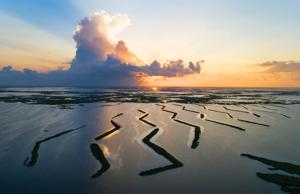Entertainment
Photographer Philip Gould Chronicles the Heart of Louisiana

Documentary photographer Philip Gould has dedicated his career to capturing the essence of south Louisiana, a place that resonates deeply with him. Since beginning his photographic journey at the age of 20, Gould has developed a profound connection to the region, which he describes as unparalleled.
Born in the San Francisco Bay Area, Gould’s fascination with photography ignited in 1971 when his mother gifted him a camera. He quickly embraced the medium, leading to a degree in photojournalism from San Jose State University. His first professional opportunity came in 1974 when he joined The Daily Iberian in New Iberia, Louisiana. For Gould, this position was “the best first job a photographer could hope for,” allowing him to explore the local landscape creatively.
After a stint in Dallas, he returned to Louisiana in 1978, drawn back by the unique cultural tapestry. “I found that Louisiana had a wonderful sense of rootedness,” he noted, appreciating the area’s French-speaking heritage and the humor of its people. This connection inspired his first book, “Les Cadiens D’Asteur: Today’s Cajuns,” released in 1980, which became a traveling exhibit.
Celebrating Louisiana Through Photography
Over the years, Gould’s work has gained recognition through exhibitions at esteemed institutions like the Field Museum of Natural History and the New Orleans Museum of Art. He has authored and co-authored 16 books, covering diverse topics from abandoned dance halls in south Louisiana to the bridges spanning the Mississippi River. His upcoming project, “Louisiana from the Sky,” set to be published by UL Press on December 9, 2023, features drone photography that offers a fresh perspective on the state’s flat landscapes.
Gould’s childhood experiences in California, where he was surrounded by dramatic mountains, shaped his belief that Louisiana’s beauty could only be fully appreciated from above. “You have to put something up in the air — so the whole flat landscape spreads out before you,” he explained, emphasizing the need for aerial perspectives to capture the state’s true essence.
When reflecting on his favorite subjects, Gould expresses a passion for photographing people within remarkable architecture. His early 2000s series on train stations in France, titled “Les Plus Belles Gares de France,” exemplifies this approach, showcasing how architecture interacts with everyday life.
A Legacy of Cultural Documentation
Mark Tullos, executive director at the LSU Museum of Art, first encountered Gould in 2002 during a festival in Lafayette. Tullos recalls Gould’s dedication to capturing the spirit of Louisiana, often seen perched atop a ladder for the perfect shot. “He’s a master of that. He’s a real visionary,” Tullos remarked, likening Gould to artists such as Fonville Winans and C.C. Lockwood.
Gould’s influence extends beyond mere documentation. Michael Martin, a history professor at UL, believes his work resonates universally, evoking emotions and experiences that transcend geographical boundaries. “You can hear the music. You can feel the dance floor kind of bouncing up and down,” Martin observed, highlighting Gould’s ability to transport viewers into the heart of Louisiana’s culture.
As Gould celebrates over five decades in photography, his images serve as more than just records of moments; they remind the people of south Louisiana of their identity. Through his lens, the ordinary transforms into something extraordinary, capturing the timeless essence of a vibrant culture.
-

 Business1 week ago
Business1 week agoIconic Sand Dollar Social Club Listed for $3 Million in Folly Beach
-

 Politics1 week ago
Politics1 week agoAfghan Refugee Detained by ICE After Asylum Hearing in New York
-

 Health1 week ago
Health1 week agoPeptilogics Secures $78 Million to Combat Prosthetic Joint Infections
-

 Science1 week ago
Science1 week agoResearchers Achieve Fastest Genome Sequencing in Under Four Hours
-

 Lifestyle1 week ago
Lifestyle1 week agoJump for Good: San Clemente Pier Fundraiser Allows Legal Leaps
-

 Health1 week ago
Health1 week agoResearcher Uncovers Zika Virus Pathway to Placenta Using Nanotubes
-

 World1 week ago
World1 week agoUS Passport Ranks Drop Out of Top 10 for First Time Ever
-

 Entertainment1 week ago
Entertainment1 week agoJennifer Lopez Addresses A-Rod Split in Candid Interview
-

 Business1 week ago
Business1 week agoSan Jose High-Rise Faces Foreclosure Over $182.5 Million Loan
-

 World1 week ago
World1 week agoRegional Pilots’ Salaries Surge to Six Figures in 2025
-

 Top Stories1 week ago
Top Stories1 week agoChicago Symphony Orchestra Dazzles with Berlioz Under Mäkelä
-

 Science1 week ago
Science1 week agoMars Observed: Detailed Imaging Reveals Dust Avalanche Dynamics







